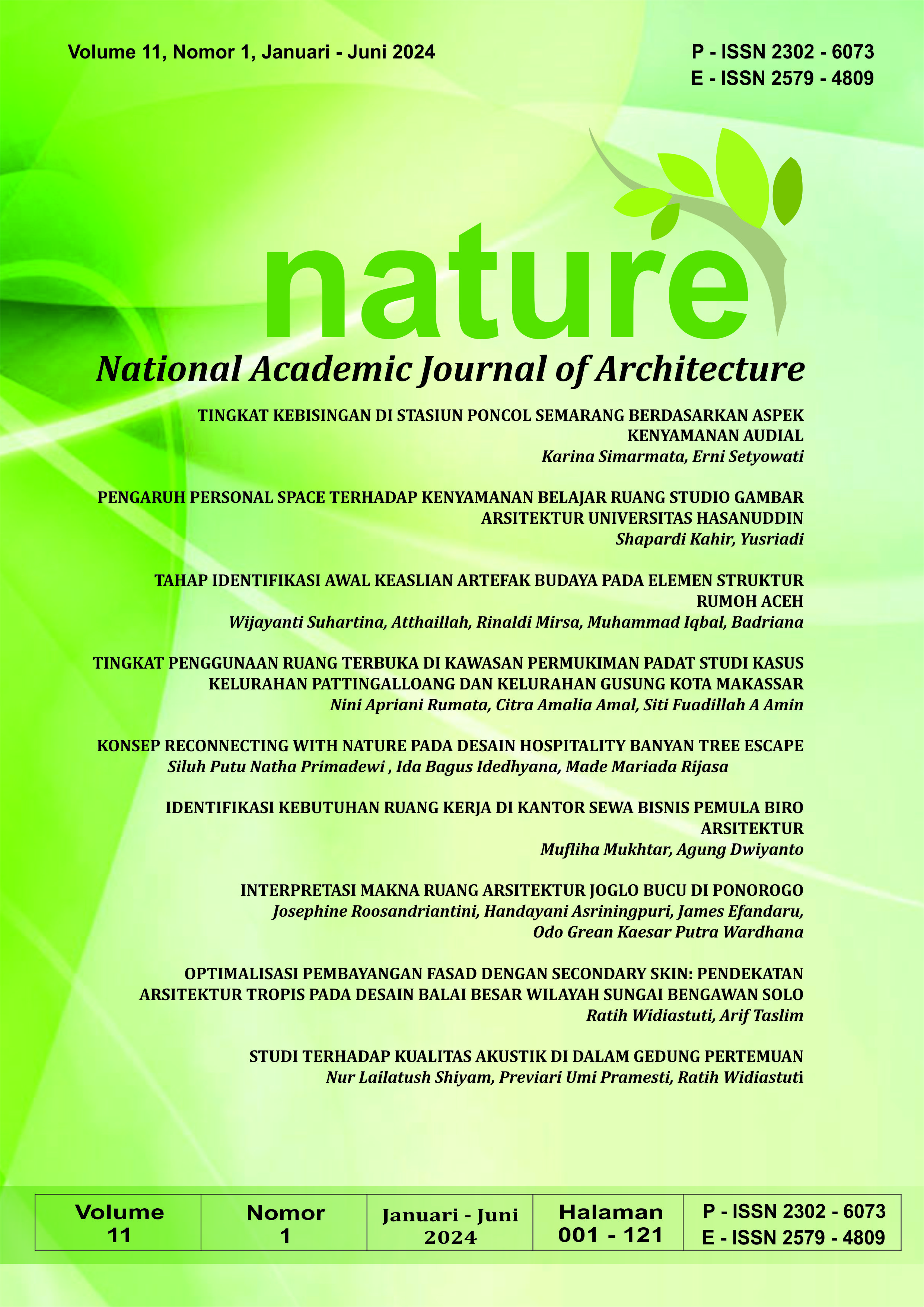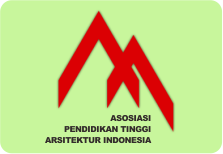Konsep Reconnecting With Nature pada Desain Hospitality Banyan Tree Escape
DOI:
https://doi.org/10.24252/nature.v11i1a5Keywords:
Sustainable Architecture, Reconnecting with Nature, Hospitality DesignAbstract
Banyan Tree Escape is located in Payangan Gianyar Bali and has a unique design concept "no wall, no door" which is rarely found in other hospitality properties. This hospitality accommodation is designed to establish a harmonious relationship between the owner and guests and re-establish the relationship between humans and the natural environment, resulting in friendly service and a pleasant atmosphere. The hospitality industry requires the presence of nature, repeated and continuous engagement with nature is very important, creating an atmosphere of relaxation that can reduce stress and provide a new sense of healthy wellness. Incorporating nature and culture into property design in the hospitality industry also aims to achieve the Sustainable Development Goals. This research aims to examine concepts that can be applied to achieve a connection with nature and sustainability goals in hospitality design. The descriptive qualitative method of case study is used in this research, guided by the concept of Reconnecting with Nature for Sustainability, followed by Biodiversity Inclusive Design analysis, Nature Climate analysis, and Vernacular Lifestyle analysis. The results show that the concept of the Biodiversity Inclusive Design approach is carried out by maintaining the condition of biodiversity, imitating the characteristics of the original/local habitat (the original habitat of Buahan Village), and the application of biophilic architecture. The concept of natural climate is applied with a combination of tropical architecture and local architecture. The Vernacular Lifestyle concept is carried out by adopting the cultural context and traditional Balinese architecture in responding to routine and boredom into relaxation.
Downloads
References
3947-3955.
Browning, W.D., Ryan, C.O., dan Clancy, J.O. (2014). 14 Patterns of Biophilic Design. New York: Terrapin Bright Green, LLC. p. 3-4, p. 47
Dapo, M. (2023, February 1). The Latest Hospitality Industry Design Trends for 2023. Torrens University Australia.
Downton, P., Jones, D., Zeunert, J., & Roos, P. (2017). Biophilic Design Applications: Putting Theory and Patterns into Built Environment Practice. KnE Engineering, 2(1), 59–65. https://doi.org/https://doi.org/10.18502/keg.v2i2.596
Fielding, B. (2020, July 12). How Hospitality Brands can Harness the Power of Nature. WATG.
Folke C, Jansson Å, Rockström J et al (2011) Reconnecting to the biosphere. Ambio 40:719–738. https ://doi.org/10.1007/s1328 0-011-0184-y
Fu, X., & You, W. (2018). Basic Green Building Design : Reconnecting Sustainability to the Vernacular. Architectural Design, 88(6), 80–87. https://doi.org/doi:10.1002/ad.2369
Genuchten, van E. (2022). How Reconnecting with Nature Improves Sustainability : And How to Revitalize Your Bond. Medium. https://medium.com/the-environment/how-reconnecting-with-nature-improves-sustainability-df8de7c6ea02
Handoko, J. P. S., & Ikaputra. (2019). Prinsip Desain Arsitektur Bioklimatik pada Iklim Tropis. Langkau Betang: Jurnal Arsitektur, 6(2). https://doi.org/10.26418/lantang.v6i2.34791
Hernandez-Santin, C., Amati, M., Bekessy, S., & Desha, C. (2022). A Review of Existing Ecological Design Frameworks Enabling Biodiversity Inclusive Design. Urban Sci, 6(4). https://doi.org/https://doi.org/10.3390/urbansci6040095
Idedhyana, I. B., Rijasa, M. M., & Saidi, A. W. (2021). Desain Biofilik pada Gedung Sekretariat dan Laboratorium Fakultas Sains dan Teknologi Universitas Ngurah Rai. Jurnal Arsitektur ARSIR, 5(2). https://jurnal.um-palembang.ac.id/arsir/article/view/3764/2683
Ives, C. D., Abson, D. J., Wehrden, H. von, Dorninger, C., Klaniecki, K., & Fischer, J. (2018). Reconnecting with Nature for Sustainability. Sustainability Science, 13, 1389–1397. https://doi.org/https://doi.org/10.1007/s11625-018-0542-9
Kindangen, J. I. (2017). Pendinginan Pasif untuk Arsitektur Tropis Lembab. Deepublish.
Lippsmeier, G. (2006). Bangunan Tropis. Erlangga.
Martin, L., White, M. P., Hunt, A., Richardson, M., Pahl, S., & Burt, J. (2020). Nature Contact, Nature Connectedness and Associations with Health, Wellbeing and Pro-environmental Behaviors. Journal of Environmental Psychology, 68. https://doi.org/https://doi.org/10.1016/j.jenvp.2020.101389
Nugroho, A. M. (2018). Arsitektur Tropis Nusantara : Rumah Tropis Nusantara Kontemporer. UB Press.
Pamungkas, L. S., & Ikaputra. (2020). Local Wisdom Arsitektur Tradisional dan Kenyamanan Termal Tropis. Arcade Jurnal Arsitektur, 4(2).
Pyle, R. M. (1993) The thunder tree: lessons from an urban wildland. Boston: Houghton Mifflin
Rantanen, J. (2009). Reconnecting with Nature And Pro-environmental Consciousness & Behavior. Sweden : Lund University. ttps://lup.lub.lu.se/luur/download?func=downloadFile&recordOId=1578607&fileOId=1578609
Rosen, E. (2022). Inside Buahan, Banyan Tree’s First Ever Escape Resort in Bali. The Points Guy. https://thepointsguy.com/reviews/buahan-bali-banyan-tree-escape/
Rossi, M., Festa, G., Papa, A., Kolte, A., and Piccolo, R. (2020). Knowledgemanagement behaviors in venture capital crossroads: a comparison betweenIVC and CVC ambidexterity. J. Knowledge Manag. 24, 2431–2454. https://www.researchgate.net/publication/359027754_Understanding_the_Cognitive_Immersion_of_Hospitality_Architecture_in_Culture_and_Nature_Cultural_Psychology_and_Neuroscience_Views
Rutes, W. A., & Penner, R. H. (1985). Hotel Planning and Design : A Guide for Architects, Interior, Designers, and Hotel Executives. Watson-Guptill Publications.
Sands, R. (2021, October 1). Innovative Hotel Design Trends That Bring The Outdoors Inside. Forbes.
Thomas, F. R. (2009). How Nature Speaks: The Dynamics of the Human Ecological Condition. Pacific Studies, Oceania Centre for Pacific Studies, Arts and Culture, University of the South Pacific, Suva, Fiji, Springer.
Wilson, E.O. 1984. Biophilia. Cambridge, Mass. and London: The Harvard University Press.
Downloads
Published
How to Cite
Issue
Section
License
Copyright (c) 2024 Made Mariada Rijasa

This work is licensed under a Creative Commons Attribution-ShareAlike 4.0 International License.
By submitting your manuscript to our journal, you are following Copyright and License






















